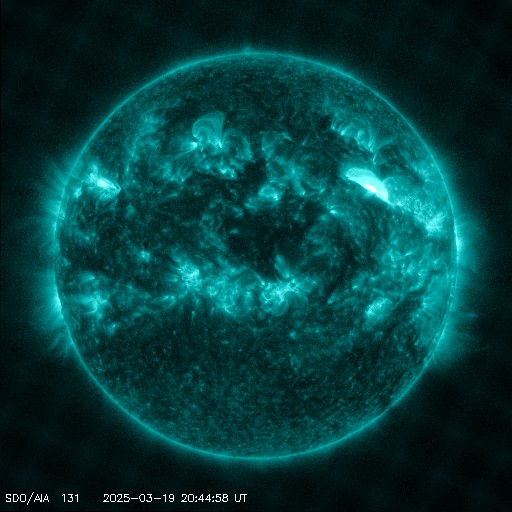Viewing archive of Friday, 10 February 2012
Solar activity report
Any mentioned solar flare in this report has a scaling factor applied by the Space Weather Prediction Center (SWPC). Because of the SWPC scaling factor, solar flares are reported as 42% smaller than for the science quality data. The scaling factor has been removed from our archived solar flare data to reflect the true physical units.
Report of Solar-Geophysical Activity 2012 Feb 10 2200 UTCPrepared by the NOAA © SWPC and processed by SpaceWeatherLive.com
Joint USAF/NOAA Report of Solar and Geophysical Activity
SDF Number 041 Issued at 2200Z on 10 Feb 2012IA. Analysis of Solar Active Regions and Activity from 09-2100Z to 10-2100Z
Solar activity was low due to C-class x-ray events from
Region 1415 (N08W84). Region 1416 (S17E10) continues to evolve
developing a beta-gamma magnetic configuration. New Region 1417
(N18E59) rotated onto the disk as a B-type group. As asymmetric,
full-halo CME was observed lifting off the NE limb, first seen in
SOHO LASCO C2 imagery at 09/2117Z. The source region for this event
appears to be located to the southwest of Region 1417. A second CME
was observed in STEREO-A and B COR2 imagery, first seen on the Ahead
spacecraft at 10/1154Z. The source of this CME appears to be a 23
degree long filament eruption, centered near S31E29. Analysis is
ongoing on the geoeffective potential of these CMEs.
IB. Solar Activity Forecast
Solar activity is expected to be low
with a slight chance for M-class activity for the next three days
(11 - 13 February) due to the return of old Region 1402 (N26,
L=218).
IIA. Geophysical Activity Summary 09-2100Z to 10-2100Z
The geomagnetic field was at quiet to unsettled levels. ACE satellite
solar wind velocities were steady through the period at about 450
km/s. The Bz component of the interplanetary magnetic field was
mostly north at about 5 nT with brief southward excursions to -4 nT.
IIB. Geophysical Activity Forecast
The geomagnetic field is
expected to be mostly quiet on day one (11 February) through midday
on day two (12 February). By midday on day two, and through day
three (13 February), field activity is expected to increase to quiet
to unsettled levels with high latitude active intervals. This
increase in activity is due to a recurrent coronal high speed stream
that is expected to rotate into a geoeffective position.
III. Event Probabilities 11 Feb to 13 Feb
| Class M | 05% | 10% | 10% |
| Class X | 01% | 01% | 01% |
| Proton | 01% | 01% | 01% |
| PCAF | green | ||
IV. Penticton 10.7 cm Flux
Observed 10 Feb 111 Predicted 11 Feb-13 Feb 115/120/120 90 Day Mean 10 Feb 135
V. Geomagnetic A Indices
Observed Afr/Ap 09 Feb 004/006 Estimated Afr/Ap 10 Feb 004/005 Predicted Afr/Ap 11 Feb-13 Feb 004/005-006/008-007/008
VI. Geomagnetic Activity Probabilities 11 Feb to 13 Feb
| A. Middle Latitudes | |||
|---|---|---|---|
| Active | 05% | 30% | 30% |
| Minor storm | 01% | 10% | 10% |
| Major-severe storm | 01% | 01% | 01% |
| B. High Latitudes | |||
|---|---|---|---|
| Active | 10% | 40% | 40% |
| Minor storm | 05% | 20% | 20% |
| Major-severe storm | 01% | 01% | 01% |
All times in UTC
Currently there's no noteworthy space weather
Latest news
Latest forum messages
CMEs from March 16-17 and small CH 87Ask your obscure/"stupid" space weather questions. 344AR 4031 2Incoming & Unnumbered Active Regions 1634Simultaneous Power Grid Failure/Blackout in couple of Balkan countries - first time in recorded history 24
More topicsSupport SpaceWeatherLive.com!
A lot of people come to SpaceWeatherLive to follow the Sun's activity or if there is aurora to be seen, but with more traffic comes higher server costs. Consider a donation if you enjoy SpaceWeatherLive so we can keep the website online!

Latest alerts
Wednesday, 19 March 2025
21:15 UTC - Geomagnetic activity
Minor G1 geomagnetic storm (Kp5) Threshold Reached: 20:59 UTC
21:00 UTC - Solar flare
Moderate M1.54 flare
20:42 UTC - Radio Blackout
Minor R1 radio blackout in progress (≥M1 - current: M1.36)
17:12 UTC - Hemispheric Power Index
The OVATION model predicts the Hemispheric Power Index to reach 52GW at 18:01 UTC
00:54 UTC - Hemispheric Power Index
The OVATION model predicts the Hemispheric Power Index to reach 113GW at 01:33 UTC
Space weather facts
| Last X-flare | 2025/02/23 | X2.0 |
| Last M-flare | 2025/03/19 | M1.5 |
| Last geomagnetic storm | 2025/03/14 | Kp6- (G2) |
| Spotless days | |
|---|---|
| Last spotless day | 2022/06/08 |
| Monthly mean Sunspot Number | |
|---|---|
| February 2025 | 154.6 +17.6 |
| March 2025 | 138.4 -16.2 |
| Last 30 days | 143 -10 |




